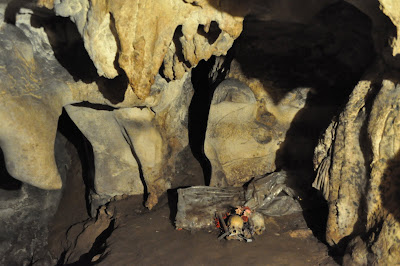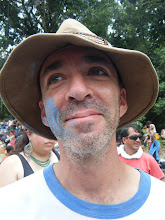We do not have a desire to see every burial ground in the region. Plus Mika and I have currently developed an unhealthy disdain for Indonesian guides, so we pick a few of the sights which sound interesting and figure out how to get there on our own.
Ke'te Kesu'
One late afternoon I go to Ke'te Kesu' myself. They have traditional style homes and rice barns still using a thatched roof instead of the corrugated tin now used everywhere. They also have old hanging graves which have been used for aristocrats. The boxes are rotted and filled with piles of bones and skulls.
 |
| Cliff burial site with hanging graves |
 |
| The traditional village |
 |
| A photo shoot for the Garuda Airlines 2011 calendar using Ke'te Kesu' as its backdrop |
Kambira
We arrive to the village Kambira by motorbike. It has baby graves inside a living Banyan tree. These are for infants who died under six months old. The white sap of the Banyan tree is supposed to be like milk to nourish the babies.
We arrive to the village Kambira by motorbike. It has baby graves inside a living Banyan tree. These are for infants who died under six months old. The white sap of the Banyan tree is supposed to be like milk to nourish the babies.
Londa
To get to Londa we take a shared taxi (which is a SUV with up to 10 passengers) to a junction and walk the remaining 1.8 km in the rain. Londa has a grave in a limestone cave. Locals hang around the entrance and for a fee will guide you through the cave with a gas light. Not wanting to shell out more cash, we opt out of this option and realize too late that caves are really dark without light. Luckily, a soccer team visiting from another part of Sulawesi takes a liking to us foreigners and coaxes us to join them and their lamp guide through the cave. Afterwards we pose for team photos.
Some other sights to see are stone monolith graves and gravestones in boulders. Being a bit "graved-out" we do not pay to see any of these. We do, however, see some examples by just passing them on the road without the 10,000 Rp fee.
Bolu
If all this death has you feeling a bit macabre then there are a few other activities to choose from. My favorite is the buffalo market in Bolu. It happens every six days. Mika decides not to pay the ubiquitous 10,000 Rp ticket and watches the buffalo from afar while I go in and slop around for a while bonding with livestock sellers and walking through mud and buffalo urine and excrement. I love markets.
Key Coffee Plantation
We also decide to go to a coffee plantation. We have a motorbike, but the road is tortuous. A steep uphill climb on a rocky road more suited for a four-wheeler or, better yet, a Humvee not our scooter. Mika has to walk up some of the worst hills and then ditches me to ride with the plantation security guard who easily passes us. I am left on my own and cursing the idea to come here. I finally arrive to Toraca Jaya Coffee plantation. The security guard is probably wondering what took me so long. This plantation was started by a Japanese man and is now producing coffee solely for Key Coffee - a Japanese company. My Japanese readers may be familiar with Key Coffee's Toraja label. All the coffee produced here goes to Japan. We are charged 10,000 Rp (US$1.10) here too. I only have about $3 and need gas money so he gives us 2-for-1 tour with free coffee included. We have a cup of Arabica. Mika says it tastes exactly like the Key coffee in Japan
Just Rambling Around
In Tana Toraja there is also a village with a natural swimming pool and another with a bat cave. Because of time and poor planning we missed these. But to be honest, some of the best parts of the area is not running around trying to see everything marked on the tourist info brochure or some guide's "must see" list. Always plopping down 10,000 Rp to see dead people in a tree or rock or cave is interesting but gets redundant. We end up really enjoying just to ride around on our motorbike and becoming part of the scenery. The sky is so blue. The rice fields and mountain jungles are shimmering green. The unmistakable Torajan roofs, buffaloes, chickens, dogs and children saying "hello Mister" are at every turn. It is so full of life.
































































